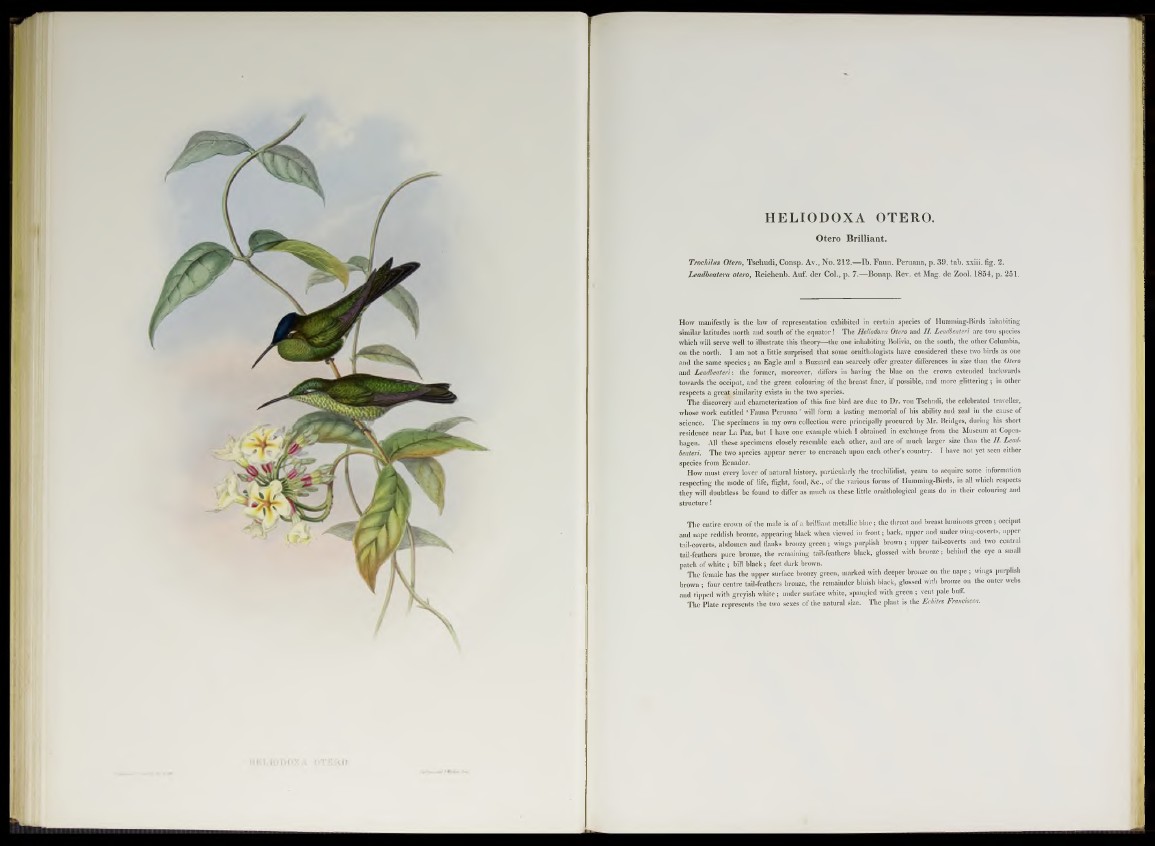
HELIODOXA OTERO.
Otero Brilliant.
Trochilus Otero, Tschudi, Consp. Av., No. 212.—Ib. Faun. Peruana, p. 39, tab. xxiii. fig. 2.
Leadbeatera otero, Reichenb. Auf. der Col., p. 7.—Bonap. Rev. et Mag. de Zool. 1854, p. 251.
How manifestly is the law of representation exhibited in certain species of Humming-Birds inhabiting
similar latitudes north and south of the equator! The Heliodoxa Otero and H. Leadbeateri are two species
which will serve well to illustrate this theory—the one inhabiting Bolivia, on the south, the other Columbia,
on the north. I am not a little surprised that some ornithologists have considered these two birds as one
and the same species; an Eagle and a Buzzard can scarcely offer greater differences in size than the Otero
and Leadbeateri: the former, moreover, differs in having the blue on the crown extended backwards
towards the occiput, and the green colouring of the breast finer, if possible, and more glittering; in other
respects a greaksimilarity exists in the two species.
The discovery and characterization of this fine bird are due to Dr. von Tschudi, the celebrated traveller,
whose work entitled ‘ Fauna Peruana ’ will form a lasting memorial of his ability and zeal in the cause of
science. The specimens in my own collection were principally procured by Mr. Bridges, during his short
residence near La Paz, but I have one example which I obtained in.exchange from the Museum at Copen-
hagen. All these specimens closely resemble each other, and are of much larger size than the H. Leadbeateri.
The two species appear never to encroach upon each other’s country. I have not yet seen either
species from Ecuador.
How must every lover of natural history, particularly the trochilidist, yearn to acquire some information
respecting the mode of life, flight, food, &c., of the various forms of Humming-Birds, in all which respects
they will doubtless be found to diflfer as much as these little ornithological gems do in their colouring and
structure!
The entire crown of the male is of a brilliant metallic blue; the throat and breast luminous green; occiput
and nape reddish bronze, appearing black when viewed in front; back, upper and under wing-coverts, upper
tail-coverts, abdomen and flanks bronzy green; wings purplish brown ; upper tail-coverts and two central
tail-feathers pure bronze, the remaining tail-feathers black, glossed with bronze; behind the eye a small
patch of white ; bill black; feet dark brown.
The female has the upper surface bronzy green, marked with deeper bronze on the nape ; wings purplish
brown ; four centre tail-feathers bronze, the remainder bluish black, glossed with bronze on the outer webs
and tipped with greyish white; under surface white, spangled with green ; vent pale buff.
The Plate represents the two sexes of the natural size. The plant is the EcAites Franciscea.